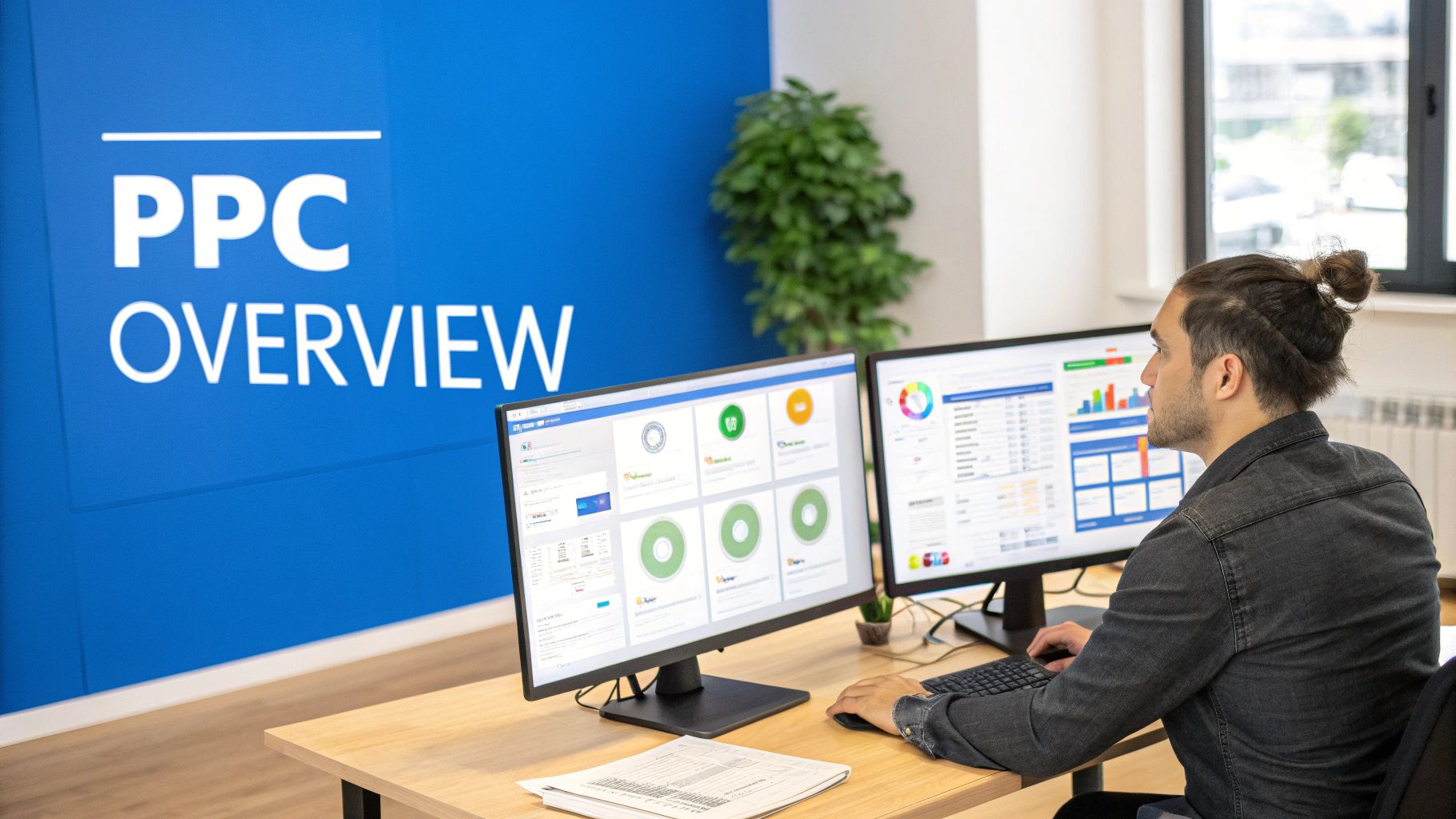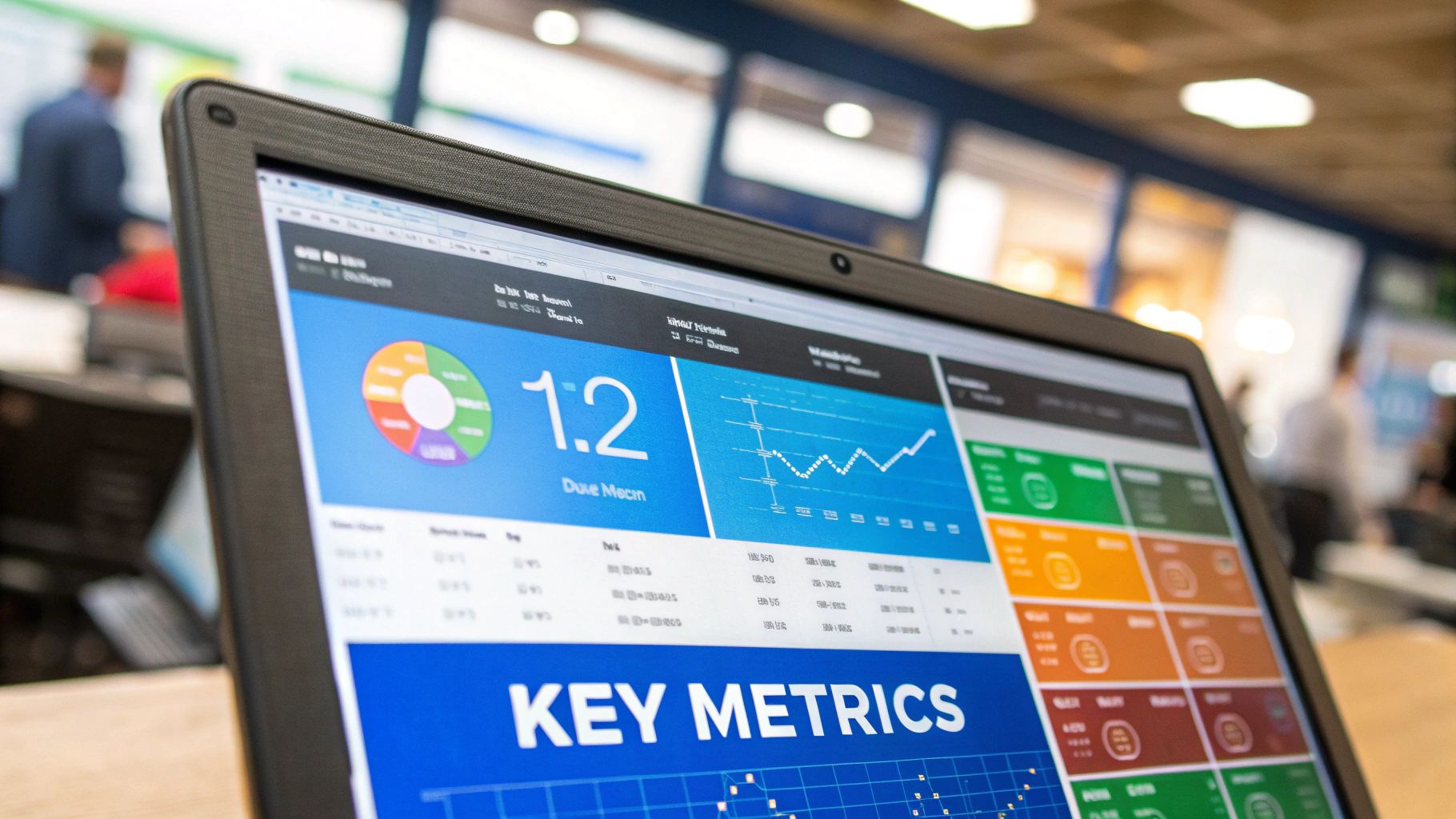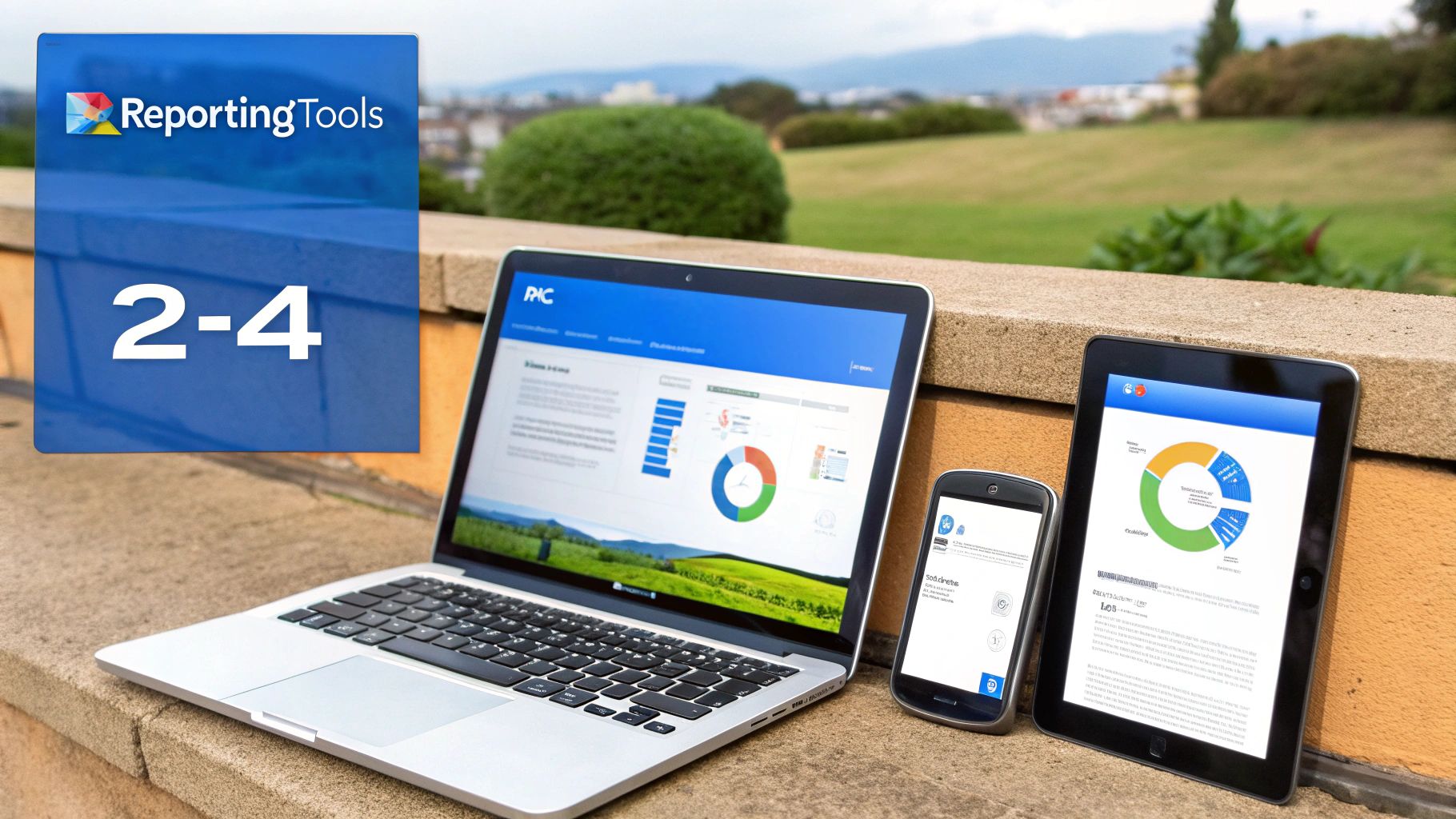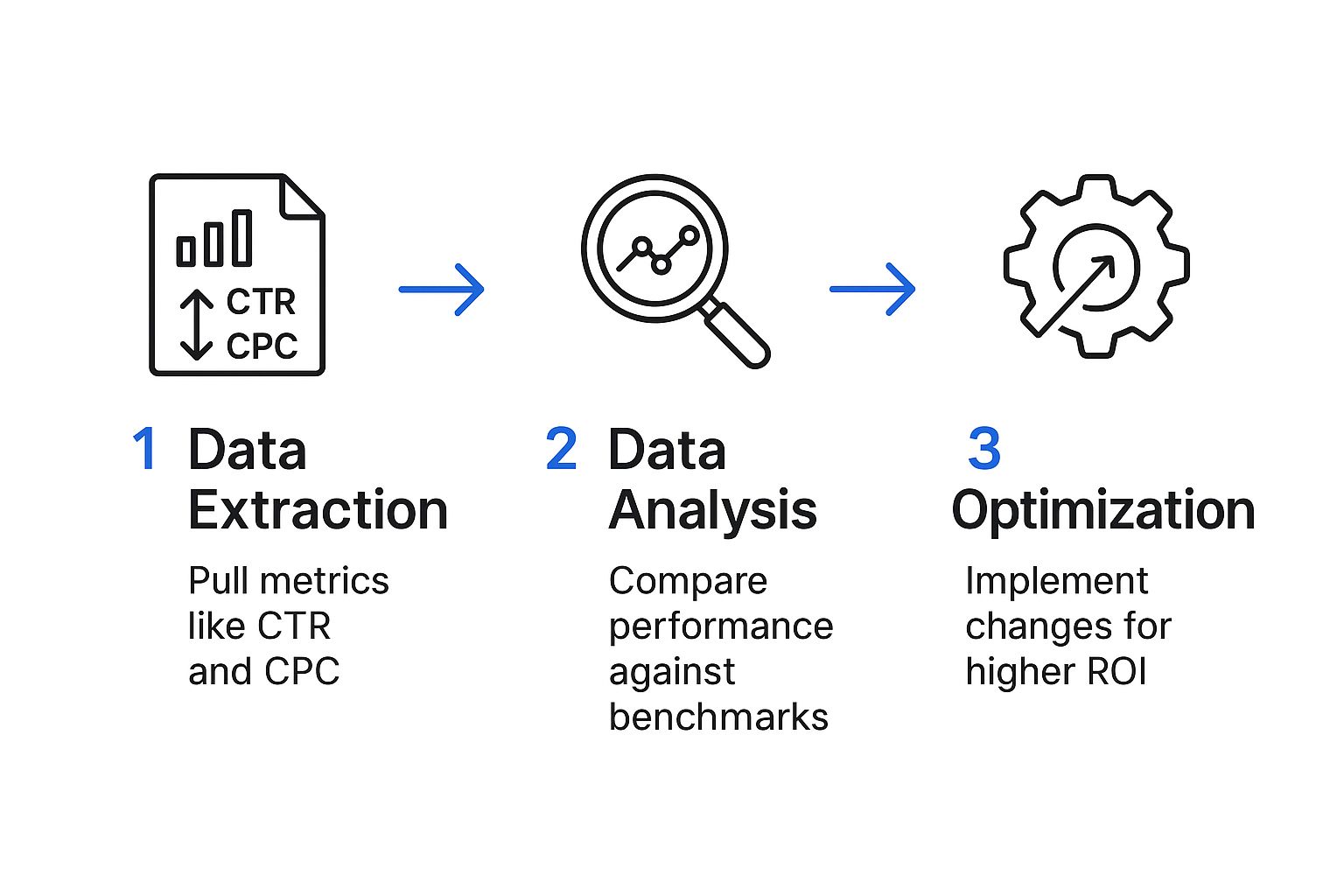A pay per click report is more than just a spreadsheet full of numbers; it’s a performance summary that tells you the story of your ad spend and whether it's actually making you money. Without one, you're basically throwing cash into a black box, hoping something good happens. You can't tell which strategies are home runs and which are just expensive strikeouts.

Think of your PPC report as the command center for your entire advertising operation. It's the dashboard that shows where you’re headed, how fast you're getting there, and whether you're about to run straight into a storm of wasted ad spend. When you master your reports, they stop being a chore and become your most powerful strategic asset.
This report is how you make smart budget decisions, prove your value to stakeholders, and spot growth opportunities long before your competitors even know they exist. It takes abstract data and transforms it into a clear narrative of what’s working, what isn’t, and—most importantly—what to do next.
The real job of a PPC report is to drive action. A good report doesn't just show you data; it answers critical business questions. You shouldn't just see a Cost Per Click (CPC) number; you should be able to look at that report and know if that CPC is delivering profitable customers.
This is exactly why PPC is still a powerhouse in modern marketing. It drives real business growth, with 80% of companies leaning on it as a core marketing channel. The numbers back it up, too—PPC traffic converts roughly 50% better than organic traffic, proving its punch in capturing users who are ready to buy.
A great report turns hindsight into foresight. It stops you from saying, "Here’s what happened," and empowers you to say, "Here's what we'll do next to win."
For marketing agencies and in-house teams alike, the pay per click report is the ultimate accountability tool. It’s the hard evidence you bring to the table to justify budgets, show progress, and build trust with clients or leadership. A clean, well-organized report showcases your strategic thinking and connects your efforts directly to the bottom line.
This is especially critical when running campaigns on specific platforms where the little details matter. For instance, if you're heavily invested in Amazon, digging into dedicated resources on Amazon advertising reporting can give you the tailored insights needed to navigate that unique ecosystem.
Ultimately, a solid PPC report fulfills three essential functions:

Let's be honest, a pay per click report can look like alphabet soup—CTR, CPC, ROAS, and a dozen other acronyms staring back at you. It’s easy to get lost in the numbers. But here’s the secret: every single metric is telling you a piece of a story about your campaign’s performance.
Your job isn't to be a data scientist. It's to be a storyteller. You just need to learn how to translate the data into a narrative that makes sense. Think of each metric as a character in a plot. Once you understand their roles, you can see how they all work together.
Let’s break down the main players.
Your story starts with two key characters: the window shopper and the buyer. These two concepts are brought to life by a couple of fundamental metrics.
Click-Through Rate (CTR) is your digital window display. It tells you what percentage of people who saw your ad were interested enough to actually click on it. A high CTR, like the 6.05% average in the dating industry, is a great sign. It means your ad creative and copy are doing their job and grabbing attention.
Cost Per Click (CPC) is the cover charge for your store. It’s what you pay each time someone "walks in the door" by clicking your ad. In super competitive spaces like legal services, that cost can be steep—sometimes over $6.75 per click. Your report will tell you if the price you're paying to get people inside is worth it.
A high CTR and a low CPC? That’s the dream. It means you're attracting a ton of people at a bargain price.
Once someone is in your "store," the story shifts to profitability. This is where the most important characters in your PPC report show up.
By connecting these dots, you stop looking at isolated numbers and start seeing a complete customer journey. You see how an eye-catching ad (high CTR) led to a profitable sale (high ROAS), turning raw data into a clear story of success.
Understanding individual metrics is step one. The real magic happens when you weave them together to tell the bigger story. A sinking CTR could be the first sign of ad fatigue. A spiking CPA might be the plot twist that tells you a new competitor just showed up.
This narrative approach is what turns a boring, static report into a dynamic tool for growth. It’s not just for PPC, either. Other industries rely on data to tell their stories, too. For example, retailers use their own key performance indicators to drive sales and make smarter strategic bets.
Once you master this translation, you can confidently explain what’s working, spot problems before they get out of hand, and build a strategy based on a clear story. To explore the tools that help automate this process, check out our guide on the best pay per click software on the market today.

Handing the same PPC report to your CEO and your campaign manager is a classic mistake. It’s like giving them both a map—one needs a high-level satellite view of the entire country, while the other needs a detailed street map of a single neighborhood. A one-size-fits-all approach just doesn’t work. It guarantees someone gets the wrong information, leading to confusion instead of clarity.
To make your data truly matter, you have to tell the right story to the right audience. Each person has a different role, asks different questions, and has a completely different idea of what success looks like. A report that ignores this will never drive the actions you want.
The real key is to get inside their head and understand what information they need to make their next big decision. When you customize your reports, you turn them from boring data dumps into strategic tools that speak directly to what each person cares about most.
Your C-suite and other company leaders are operating at 30,000 feet. They aren't worried about the daily ups and downs of Click-Through Rate (CTR) or what you’re bidding on a specific keyword. Their focus is on the bottom line: Is this investment actually making us money?
An effective executive dashboard is quick, visual, and all about business outcomes. It answers the big-picture questions without getting lost in the weeds.
This high-level view gives leadership the confidence they need to keep funding your paid media efforts.
While executives need to know what happened, your in-the-trenches campaign managers need to know why it happened. This report is their tactical playbook for daily and weekly optimizations. It’s less about a beautiful presentation and more about data they can actually use.
This is where you dig deep into the mechanics of the campaigns to find those golden opportunities for improvement. The details here are what fuel smarter bidding, better targeting, and more effective ad creative.
A campaign manager's report isn't about proving value to others; it's about finding the levers to pull to create more value tomorrow. It’s a workshop, not a showroom.
For your managers, the pay per click report should be packed with performance details like:
This is the kind of detail needed to really fine-tune campaigns. If your team is juggling this level of complexity across multiple clients or channels, checking out different PPC management software solutions can be a lifesaver.
The global PPC advertising market is massive and still climbing, with search ad spending worldwide expected to hit $351.55 billion by 2025. Google Ads is still the king with a 69.04% market share, but savvy marketers know that putting all your eggs in one basket is a risky move. To see the full picture, you need platform-specific reports.
These reports help you compare apples to apples, not apples to oranges. What’s considered a “good” CPA on Facebook Ads might look totally different from a good CPA on Google Search. By creating separate reports for each channel, you can judge performance in the right context and make much smarter decisions about where to put your next dollar.
Creating a PPC report that people actually want to read isn't about technical wizardry. It’s about telling a clear, logical story with your data. The best reports don't just dump a bunch of numbers into a spreadsheet; they guide the reader from a high-level summary all the way down to the nitty-gritty details that spark real action.
Your goal is to build a document that’s both insightful and instantly easy to grasp. Think of it as taking your stakeholders on a journey, showing them not just what happened, but why it happened and what you’re going to do about it next. Let’s break it down into four simple steps.
Always start with the bottom line. Before you get into the weeds of campaign performance, give your audience a quick, top-line executive summary. This should be a brief paragraph or two that answers the most important questions right off the bat. It's like the trailer for a movie—it hooks them and tells them why they should pay attention.
Your summary needs to cover:
This approach respects everyone's time by delivering the must-know info upfront. Even if someone only reads this part, they’ll walk away with a solid grasp of the campaign's success.
Once you’ve set the stage, it's time to structure the rest of the report. The key is to flow from the big picture down to the finer details. This logical flow keeps your audience from getting lost in the data. A simple, effective structure looks like this:
This layered approach lets you tell a compelling story that connects high-level outcomes to the specific tactics that made them happen. For a more in-depth look at structuring these reports, check out our complete guide to PPC reporting.
Numbers on a page are easy to forget. Visuals stick. Use simple charts and graphs to bring your data to life. You don’t need to be a design pro—a few well-chosen visuals can communicate trends and comparisons way more effectively than a dense table of numbers ever could.
Visuals turn data into insight. A simple line graph showing a decreasing CPA is more powerful than a paragraph explaining the same trend. It makes the "win" feel immediate and obvious.
This infographic shows exactly how raw data gets transformed into real optimization through a clear, actionable process.

The flow here, from extraction to optimization, drives home the point that a report's true job is to fuel action and improve ROI.
This is the most critical part. Don't just end your report—close it with clear, actionable next steps. Based on everything you've just shown, what should you do next to make things even better? Get specific. Don't just say "we will optimize campaigns." Instead, propose a concrete action like, "We will reallocate 15% of the budget from Campaign B to Campaign A to capitalize on its higher ROAS."
This final step is what turns your PPC report from a backward-looking document into a forward-thinking strategic plan. It proves your value by showing you aren't just a number-watcher; you're actively driving the business forward. Given that 55% of companies now hire specialized agencies to manage their campaigns, providing this kind of strategic guidance is what will make you stand out from the crowd.
A pay per click report is only as valuable as the actions you take because of it. It’s easy to get bogged down in data collection, but the real skill is becoming a data detective. You have to learn how to uncover the hidden stories and opportunities your numbers are trying to tell you.
This means shifting your mindset from just reporting what happened to analyzing why it happened—and what you should do next.
Think of your report as a treasure map. The metrics are just landmarks. The real prize—the actionable insights—is the buried treasure. To find it, you need to start asking the right questions and looking for patterns. The goal isn't just to see a number, like a $50 CPA, but to understand the story behind it and use that story to make smarter decisions.
To start finding these insights, you need a framework for analysis. Don't just scan the numbers; interrogate them. Every metric is a clue that can lead you to a campaign-changing discovery.
Start by asking targeted questions that force you to connect the dots between different data points:
When you frame your analysis around these kinds of questions, you move beyond just stating facts and start diagnosing real problems.
A report shows you that your CPA went up by 20%. An actionable insight tells you it went up because a new competitor entered the auction, driving up your average CPC by 35% on your top three keywords.
This is the level of detail that separates a basic report from a strategic one. It points you directly to a solution, like adjusting your bidding strategy or refreshing your ad copy to stand out.
Once you've diagnosed a problem or spotted an opportunity, the next step is to form a testable hypothesis. This is how you turn insights into consistent, repeatable improvements.
Let’s walk through a real-world scenario. Your report shows a campaign’s CPA is slowly creeping up. After digging a little deeper, you notice that while the desktop CPA is stable at $45, the mobile CPA has ballooned to $90. That is your insight.
Now, you can form a hypothesis: "Our landing page isn't optimized for mobile users, which is causing a lower conversion rate and a higher CPA on mobile devices."
Suddenly, your next moves become crystal clear:
This approach creates a cycle of continuous improvement driven by your pay per click report. For marketers managing multiple campaigns, using specialized tools is the only way to do this effectively. Exploring different PPC reporting software options can help automate the data-gathering part, freeing you up to spend more time finding these critical, actionable insights.
Think of your PPC report as a diagnostic tool. When you see a "symptom" in your data, you can trace it back to a likely cause and implement a fix. The table below outlines some common issues you might find in your reports and what your next moves should be.
Symptom in Your ReportLikely CauseYour Next MoveHigh Impressions, Low CTRAd copy is boring or irrelevant; your audience isn't connecting with the message.A/B test new headlines and ad copy. Try a completely different angle.High CTR, Low ConversionsThe ad is great, but the landing page isn't delivering on the promise.Check for message match between the ad and landing page. Simplify the form. Improve page speed.High CPAOverly broad targeting; high competition on keywords; poor ad relevance.Narrow your audience targeting. Add negative keywords. Improve your Quality Score.Sudden Drop in ImpressionsDisapproved ads; budget ran out; new competitor outbidding you.Check ad status in the platform. Review budget pacing. Analyze the auction insights report.ROAS is Decreasing Over TimeAd fatigue; increased competition; seasonal changes in buying behavior.Refresh your ad creative. Test new offers. Adjust bids for seasonality.
Using this framework helps you move from simply observing data to actively solving problems. Every report becomes a chance to get a little bit better, cut waste, and push your campaign performance to the next level.
Even when you feel like you have a handle on building and reading PPC reports, a few questions always seem to pop up. That’s totally normal. This section tackles some of the most common questions we hear from marketers, giving you clear answers to help you sharpen your reporting process and share results like a pro.
Let’s get into the nitty-gritty details that can take your reporting from a good habit to your team’s secret weapon.
There’s no magic number here—the right reporting schedule really depends on what you’re trying to accomplish and who’s reading the report. Think of it like checking on a garden. Some plants need daily attention, while others thrive with a simple weekly check-in. It's all about matching the cadence to the goal.
This is a big one. While ROAS and ROI both measure profitability, they tell two very different stories about your campaign's financial health. Getting them mixed up can give you a dangerously warped view of your marketing’s actual value.
ROAS (Return on Ad Spend) is a straightforward, top-line metric that tells you how efficient your advertising is. It only compares the revenue generated directly from your ads against what you spent on those ads. The formula is simple:
ROAS = Total Revenue from Ads / Total Ad Spend
So, a 4:1 ROAS means you’re making $4 in revenue for every $1 you spend on ads. It answers the question: "Is this ad campaign making money on its own?"
ROI (Return on Investment), on the other hand, is a true business metric. It zooms out to measure the total profit from your marketing effort after all associated costs are subtracted—not just ad spend. This includes everything from agency fees and software costs to salaries and creative production.
ROI = (Net Profit / Total Investment) x 100
Think of it this way: ROAS tells you if your ads are working. ROI tells you if your entire marketing initiative is actually profitable for the business. To get a handle on the bigger picture, you can use a dedicated advertising ROI calculator to see how all your costs stack up.
Let's be honest: building detailed PPC reports by hand every week is a soul-crushing, error-prone task. Automating the process is a complete game-changer. It frees you from the drudgery of pulling data so you can spend your time where it counts—analyzing it for insights that move the needle.
The absolute best way to do this is with a dedicated reporting platform. These tools plug directly into your ad networks (like Google, Meta, and TikTok) and analytics platforms, pulling all your data into one unified dashboard.
When you're looking for a tool, make sure it offers:
When you automate, your reports become consistent, accurate, and always on time. This not only builds trust with clients and leadership but also frees up countless hours for your team.
Ready to stop wasting time on manual reports and start finding actionable insights? Cometly unifies your marketing data, automates your reporting, and gives you the attribution insights needed to prove and improve your ROI. Discover how Cometly can transform your PPC reporting today.
Learn how Cometly can help you pinpoint channels driving revenue.
.svg)
Network with the top performance marketers in the industry